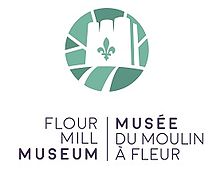
Sudbury, officially Greater Sudbury, is a city in Ontario, Canada. It is the largest city in Northern Ontario by population, with a population of 166,004 at the 2021 Canadian Census. By land area, it is the largest in Ontario and the fifth largest in Canada. It is administratively a single-tier municipality and thus is not part of any district, county, or regional municipality. The City of Greater Sudbury is separate from but entirely surrounded by Sudbury District.

The Regional Municipality of Sudbury was a Regional Municipality that existed in Ontario, Canada, from 1973 to 2000, and was primarily centred on the city of Sudbury. It served as an upper-tier level of municipal government, aggregating municipal services on a region-wide basis like the Counties and Regional Municipalities of Southern Ontario, and was the only upper-tier municipal government ever created in Northern Ontario. The Regional Municipality was dissolved with the creation of the amalgamated City of Greater Sudbury on January 1, 2001.

Walden was a town in the Canadian province of Ontario, which existed from 1973 to 2000. Created as part of the Regional Municipality of Sudbury when regional government was introduced, the town was dissolved when the city of Greater Sudbury was incorporated on January 1, 2001. The name Walden continues to be informally used to designate the area.

Nickel Centre was a town in Ontario, Canada, which existed from 1973 to 2000.
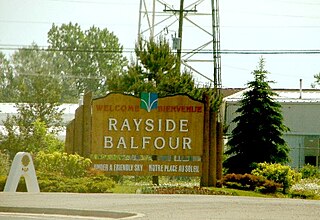
Rayside-Balfour was a town in Ontario, Canada, which existed from 1973 to 2000. It is now part of the city of Greater Sudbury.

Onaping Falls was a town in the Canadian province of Ontario, which existed from 1973 to 2000. It was created as part of the Regional Municipality of Sudbury, and took its name from the waterfalls on the Onaping River.
Falconbridge Limited was a Toronto, Ontario-based natural resources company with operations in 18 countries, involved in the exploration, mining, processing, and marketing of metal and mineral products, including nickel, copper, cobalt, and platinum. It was listed on the TSX and NYSE (FAL), and had revenue of US$6.9 billion in 2005. In August 2006, it was absorbed by Swiss-based mining company Xstrata, which had formerly been a major shareholder.
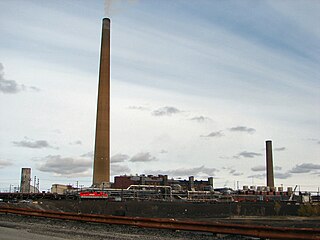
The Inco Superstack in Sudbury, Ontario, with a height of 381 metres (1,250 ft), is the tallest chimney in Canada and the Western hemisphere, and the second tallest freestanding chimney in the world after the GRES-2 Power Station in Kazakhstan. It is also the second tallest freestanding structure of any type in Canada, behind the CN Tower but ahead of First Canadian Place. It is the 51st tallest freestanding structure in the world. The Superstack is located on top of the largest nickel smelting operation in the world at Vale's Copper Cliff processing facility in the city of Greater Sudbury.

Greater Sudbury City Council is the governing body of the City of Greater Sudbury, Ontario, Canada.

The Big Nickel is a nine-metre replica of a 1951 Canadian nickel, located at the grounds of the Dynamic Earth science museum in Greater Sudbury, Ontario, Canada, and is the world's largest coin. The twelve-sided nickel is located on a small hill overlooking the intersection of Municipal Road 55 and Big Nickel Drive at the westernmost end of the Gatchell neighbourhood.
King's Highway 144, commonly referred to as Highway 144, is a provincially maintained highway in the northern portion of the Canadian province of Ontario, linking the cities of Greater Sudbury and Timmins. The highway is one of the most isolated in Ontario, passing through forest for the majority of its 271 km (168 mi) length. It is patrolled by the Ontario Provincial Police and features an 80 km/h (50 mph) speed limit.
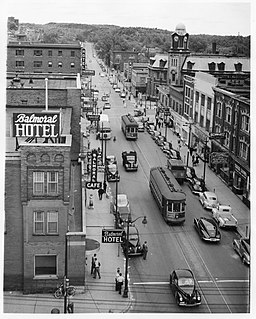
The Sudbury and Copper Cliff Suburban Electric Railway was a privately-owned electric interurban railway and streetcar system that connected several neighbourhoods in the town of Sudbury, along with what was then the town of Copper Cliff in Ontario, Canada. Incorporated in 1912, the company began revenue passenger service in November 1915. It ultimately grew into a system of three radial lines which joined together in downtown Sudbury. By the late 1940s, however, rail service was being supplemented with diesel buses. Rail service ended in October 1950 and was completely replaced with bus service, which over time evolved into municipal Sudbury Transit and later GOVA services.

GOVA, formerly known as Greater Sudbury Transit, is a public transport authority that is responsible for serving bus routes in Greater Sudbury, Ontario, Canada and area. The network is the largest in Northern Ontario, comprising 41 routes operating between the hours of 5:00am to 10:00pm for regular service and from 10:00pm to 2:00am for night service. Due to the increase in ridership the service has been approved for articulating buses primarily used for the largest routes and during rush-hour times. The annual ridership for the year of 2014 was recorded at 5 million passengers at an estimate of 16,000 daily.
The Greater Sudbury municipal election, 2006 was held in the city of Greater Sudbury, Ontario, Canada on November 13, 2006. All municipal elections in the province of Ontario are held on the same date; see 2006 Ontario municipal elections for elections in other cities.

Nickel Belt is a provincial electoral district located in the Canadian province of Ontario. It elects one member to the Legislative Assembly of Ontario. The district is located in Northern Ontario and includes much of the eastern and southern parts of the District of Sudbury, as well as most of Greater Sudbury outside the city's urban core. Communities include Lively, Onaping, Levack, Dowling, Chelmsford, Naughton, Azilda, Coniston, Wahnapitae, Garson, Val Caron, Val Thérèse, Hanmer and Capreol.

This is a list of neighbourhoods in the urban core of Greater Sudbury, Ontario. This list includes only those neighbourhoods that fall within the pre-2001 city limits of Sudbury — for communities within the former suburban municipalities, see the articles Capreol, Nickel Centre, Onaping Falls, Rayside-Balfour, Valley East and Walden.
Azilda station is a Via Rail flag stop station located in Azilda, Ontario, in the city of Greater Sudbury community of Rayside-Balfour. It is on the Canadian Pacific Railway transcontinental main line, and is served by the regional rail Sudbury – White River train.
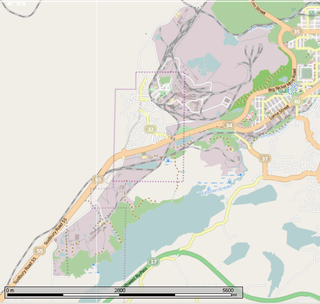
The Vale Railway, formerly the INCO Railway, is an industrial railway operating in the City of Greater Sudbury, Ontario, Canada. It is owned and operated by Vale Limited.
The economy of Greater Sudbury, Ontario was dominated by the mining industry for much of the city's history. In recent decades, however, the city has diversified to establish itself as an emerging centre in a variety of industries, including finance, business, tourism, health care, education, government, film and television production, and science and technology research. Many of these industries reflect the city's position as a regional service centre for Northeastern Ontario.
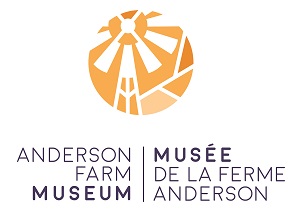
The Anderson Farm Museum is a local history museum, heritage centre, and event space in Lively, Greater Sudbury, Ontario, Canada. It is located on the site of the former Anderson family farm, a 14-acre (57,000 m2), mostly-outdoor site containing the original farm buildings, artifacts from local history, as well as a heritage building from the former community of Creighton.





